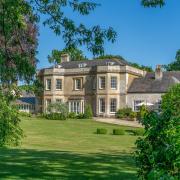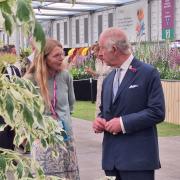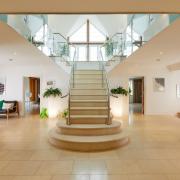Good garden design is about so much more than merely creating a pleasing arrangement of plants. The strikingly modern house shouldn’t sit comfortably in the Cotswold countryside setting but it does, thanks to a design whose curved silhouette echoes the contours of the land and a garden that marries the two.
The house is intimately linked to the immediate garden with a sense of one flowing into the other, while the formal areas are carefully transitioned into a wildflower meadow and orchard that don’t jar with fields of sheep beyond.
It was created by award-winning Cotswold designer Chris Beardshaw who fully appreciated the challenge involved: ‘It’s a complex piece of architecture, and there’s also a fabulous landscape to be seen beyond the garden. What you want is a garden that is supportive of all those elements, not a garden that is trying to shout against them.’

It was the situation, a southwest-facing hillside near Chipping Norton, that first attracted his clients rather than the uninspiring 1970s house in bad repair.
‘They fell in love with the topography and saw the opportunity the site offered.’
Chris joined the project from the start and worked closely with the architect to ensure garden and house were developed sympathetically.
‘You’re able to modify and refine the designs for the garden once you see the house starting to come out of the ground. You get that kind of perfect marriage between the intimate, domestic garden and the internal.’

Working alongside the house build also means potential eyesores such as the position of inspection covers can be designed into the hard landscaping where they can be disguised.
‘You don’t then find yourself having to compromise the garden or the design.’
One consequence of his early involvement was the realisation that hundreds of cubic metres of soil, dug out to embed the house into the hillside, needn’t be taken off-site. Instead, it’s been used to slightly raise the valley floor, reducing costs and the environmental impact.
His team also worked with the builders to ensure there was minimal impact from construction work on the shallow clay soil, with measures taken to protect the ground.

Although work on the garden proper couldn’t start for nearly 18 months, the time was used to prepare the framework, laying and replanting hedges, putting in trees and getting the fields back into a good state for sheep.
Around 200 trees were taken out of a completely impenetrable copse where trees had been planted in a grid and then abandoned. Today, it has paths woven through and it’s part of a vista from the house to ponds below.
Indeed, putting in a natural water feature was something that Chris envisaged on his first visit to the project before the old house was demolished.

‘I got to the low point in the valley and immediately felt the first experience of the site should be a watercourse that is seamless and appears to reach off into the distance.’
The irregular shape of the lake and using native marginals, such as flag iris, to soften the edges give it a natural feel, creating a lovely place to sit.
Changing the approach to the house was also an early decision and the originally straight drive is now curved, forcing you to slow and relax.

With its stark stonework, curved lines and hillside position, there was a danger the house would dominate the landscape so soft landscaping has been used to shroud it.
Part of that screening is an ‘old-fashioned’ orchard with Cotswold varieties of apples, plums, pears and damsons specially grafted onto old rootstocks that will allow them to grow into orchard-sized trees.
To one side of the house, there’s a group of silver birch and pines, underplanted with Iris sibirica ‘Perry’s Blue’, ferns and other shade-lovers, that echoes the copse on the other side.
The wildflower meadows are referred to as the ‘Royal meadows’ because the seed mix was inspired by those at Highgrove. They give a soft, natural approach to the orchard and then the garden proper.

‘We’re using the meadows as a kind of subtle introduction to a more choreographed and a more manicured piece of work as you as you approach the house.’
Parking has been deliberately moved into the ‘outer courtyard’ so that you can look back and admire both the house and the view.
Three old espalier-trained pear trees flank one section of the retaining wall, referencing the orchard below. These were commercial orchard trees that were being ‘decommissioned’ and now have a retirement home in the garden.
‘The maturity of the trees give a kind of gravitas to the design,’ comments Chris.

Raised slightly above this area is the kitchen garden with angular raised beds made of old oak sleepers. It’s an ideal space as it has some protection from walls, while creating raised beds meant good soil could be imported.
‘One of the beauties of this project is that, partly because of the topography, but also because of the way the building flows out from the landscape, it was very easy to divide down into a series of choreographed spaces and each was able to have its own its own personality.’
The upper orchard, set high up above the house, has longer grass, wild roses, and fruit trees dotted around rather than in straight lines.

‘It’s a very deliberate attempt to choreograph the space as a different experience,’ explains Chris. ‘They're looking across the roof of the Cotswolds and so it needs to be wilder, windswept and a bit earthy, and the plants need to look as though they've seen some action in life because of the more hostile climate.’
In contrast, the back of the house opens out onto a formal garden that has a protected, sheltered atmosphere.
It’s designed to flow easily from the building – porcelain paving against doors is aligned with flooring inside, while the retaining walls that create the level space are made from the same limestone block as the house. Bonded gravel for paths adds a touch of informality in what is a country garden.

The planting is dense but doesn’t overwhelm because care has been taken to ensure not everything flowers at once.
‘There’s a huge variety in the plant listing, but the sequencing of those plants means that there’s probably only half a dozen that are really calling for your attention at one time.’
Multi-stemmed trees, chosen because they are easier to keep small, are underplanted with geraniums, alliums, iris, penstemon, salvia and euphorbia in a colour palette of white, purple and blue.

The season starts with a sequence of bulbs, including snowdrops, winter aconites and scillas, with autumn colour coming from trees and shrubs.
A sunken, formal pool with bubble jets adds the soothing sound of water and there’s a large entertaining area to one side of the terrace.
‘There’s an awful lot placed within a very small space.’
For Chris, the success of a project is judged by the clients’ reaction to it: ‘It’s lovely when you see somebody who is a nervous gardener turn into a confident garden-lover who wants to celebrate that space and wants to tell others about it. Then we’ve done our job.’
Instagram: @thechattygardener
Facebook: The Chatty Gardener
X (Twitter): @ChattyGardener



























